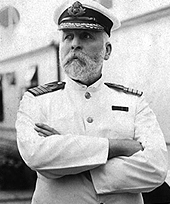Edward John Smith

Date of birth: 27 January 1850
Place of birth: Hanley, Staffordshire, England
Marital status: Married
Spouse: Sarah Eleanor Pennington
Children: Helen Melville Smith (1898–1973)
Address: Woodhead, Winn Road, Portswood, Southampton, Hampshire, England
Crew position: Titanic's Captain
Date of death: 15 April, 1912
Cause of death: Unconfirmed; body never recovered